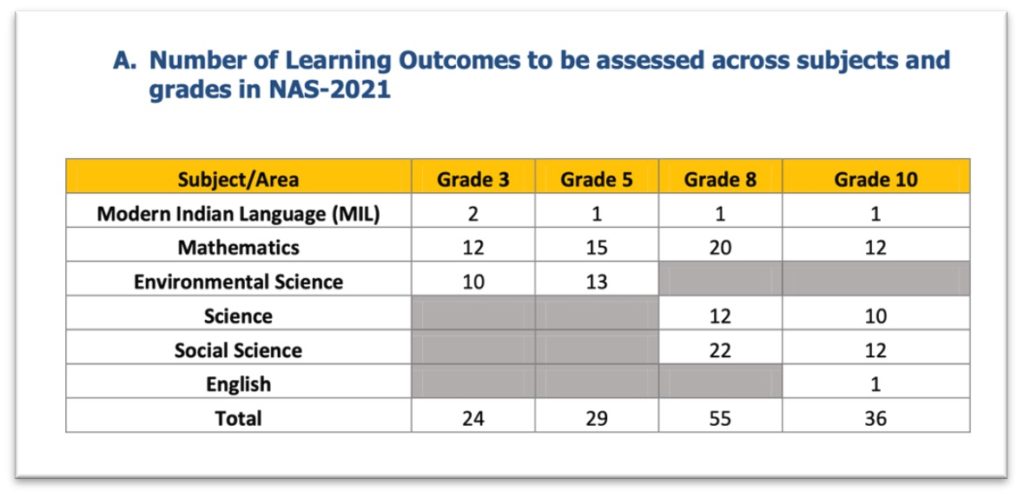Multiple global surveys have highlighted the significant impact of COVID-19 on school going children & their learning levels. In India, two different school education related surveys provide insights into children’s education. The ASER is by a non-government organization, and the NAS is conducted by the government. Here is a comparative review of both.
Education is one of the major areas that was directly impacted by the COVID-19 pandemic. Lockdown & other quarantine measures across the world resulted in the shutting down of schools, thereby creating challenges in access to education.
As per World Bank, based on a study across Europe and Central Asia, around 185 million students were affected due to the closure of schools during the peak of the pandemic. Studies show that while children from socioeconomically well-off families received more parental support and access to online resources, the learning loss for those from less-educated and less-privileged homes was alarmingly high.
UNICEF’s “Situation Analysis on the Effects of and Responses to COVID-19 on the Education Sector in South Asia” highlights the impact of COVID-19 on education in the region. Around 389 million students have been impacted by school closures. It is estimated that around 24 million learners globally might not return to education and another 20 million secondary-school age girls might be out of school after the crisis.
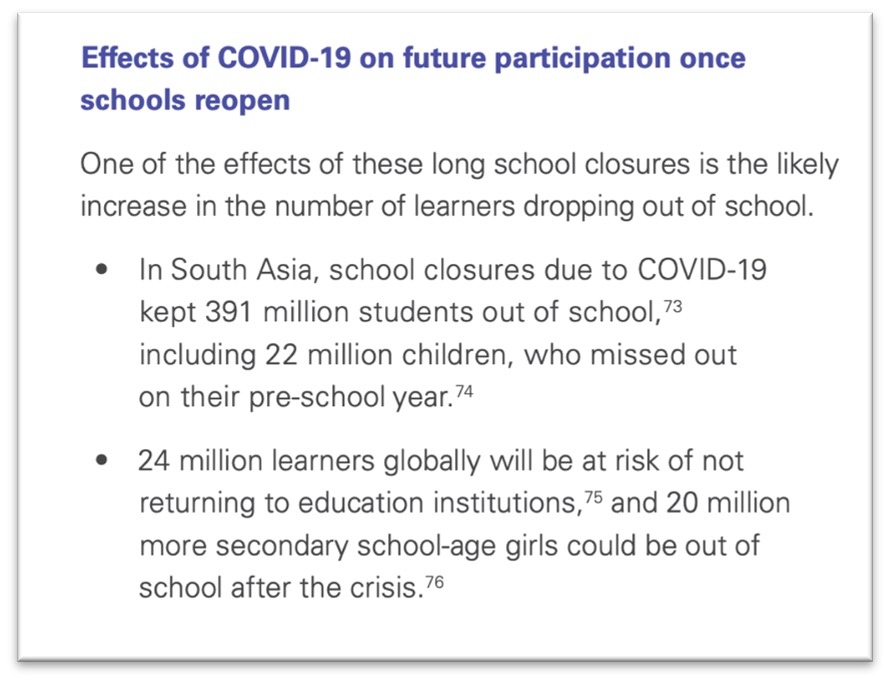
India specific surveys – ASER & NAS
As per international studies, even the situation in India presents a gloomy picture like the world over. In this context, two surveys carried out regularly can provide deeper insights into the impact of COVID-19 on education.
- The Annual Status of Education Report (ASER). The 2021 edition of the report was released on 17 November 2021. ASER surveys are organized annually.
- National Achievement Survey – 2021 (NAS), conducted on 12 November 2021, of which the results are awaited. NAS is conducted every three years.
While the purpose of both surveys is to reflect upon the status of education in the country, the parameters studied in these surveys vary. Here is a look at both ASER-2021 and NAS -2021, and how they differ in terms of survey methodology & the parameters they study.
Scope of these Surveys
Understanding the impact of COVID-19 on the learning of children is the key goal of both the ASER-2021 and NAS-2021. However, the approach and methods used to ascertain the impact of learning varies.
ASER 2021: ASER-2021 explored the impact of COVID-19 on various factors influencing students learning. ASER is a citizen-led household survey that provides nationally representative estimates of children’s schooling status along with their foundational reading and arithmetic skills.
It was an annual survey during 2005 and 2014 and then conducted in alternate years until 2018. The survey is conducted for children in the age group of 3-16 years in nearly all the rural districts of the country.
With the COVID-19 pandemic in 2020, and schools shutting down in March’2020, there arose a need to capture the impact of the pandemic and school closures on children’s access to learning opportunities. COVID-19 pandemic also made it impossible for a field-based survey. Hence ASER-2020 was redesigned as a phone survey and new additions were made to gather information on the impact of the pandemic on different aspects of children’s education. ASER -2021, retains the phone survey format and a few critical areas were emphasized.
Few of the critical areas covered in ASER-2021 include– children enrolment, tuition classes, smartphones, access to learning materials, learning support at home, etc.
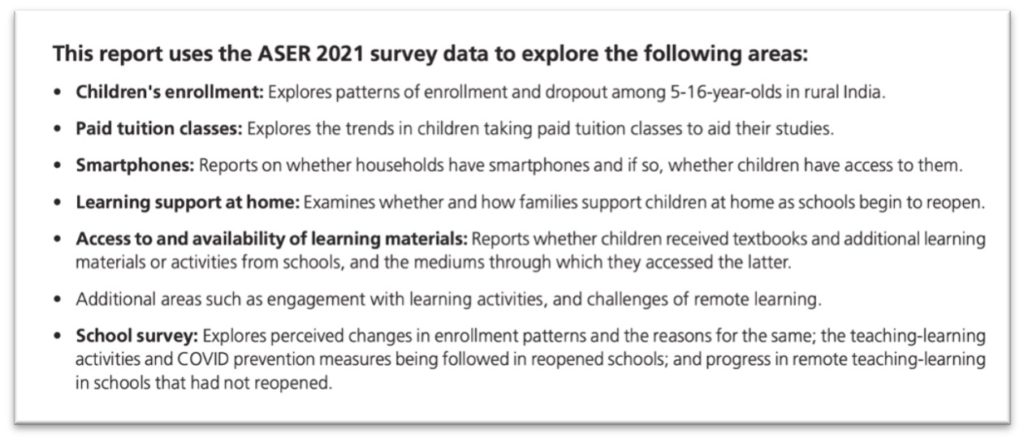
Information relating to taking up private tuition classes, access to smartphones, learning support at home, etc. were introduced in ASER-2020 in wake of the COVID-19 pandemic and continued even in 2021. Another important aspect for which the data was gathered in ASER-2021 is relating to the re-opening of the schools, which was not the case in 2020.
NAS- 2021: NAS-2021 is focused on measuring the learning levels and impact of COVID-19. NAS-2021 was conducted by the Central Government’s Ministry of Education on 12 November 2021.
The NAS was launched in 2001-02 and is a school-level survey. The earlier iteration of the survey was NAS-2017. NAS-2021 is a nationwide survey and conducted for Classes 3,5,8 & 10, with the help of the National Council of Education Research and Training (NCERT) and the Central Board of Secondary Education (CBSE). NAS attempts to assess grade-level competencies of children through the testing instruments prepared by NCERT for each of the classes. NAS 2021 was conducted in 22 languages for various subjects.

Apart from the assessment that would evaluate the learnings, there is also a questionnaire that to collect background information. The coverage includes:
- Family background
- Facilities at home
- Involvement of parents
- Safety & facilities in school
- Learning during pandemic
It also includes questions relating to learning for children with special needs.
Unlike ASER-2021, which focused on areas related to COVID-19 like availability of mobile phones, access to private tuitions, etc., NAS-2021 does not have questions that might directly provide information on the other factors influenced by COVID-19. However, the background information being collected as part of NAS-2021 could throw light on the diversity of the access to facilities for the students, especially during the pandemic.
NAS-2021 is considered as the most important of the NASs conducted so far, since it throws light on the impact on the learning gains made over the years, with schools being closed due to the pandemic.
Coverage of the Surveys & Participation
ASER -2021 covered nearly all the rural districts i.e., 581 districts across 25 states & 3 UTs. More than 75 thousand children aged 5-16 years and around 76.7 thousand households were part of the survey.
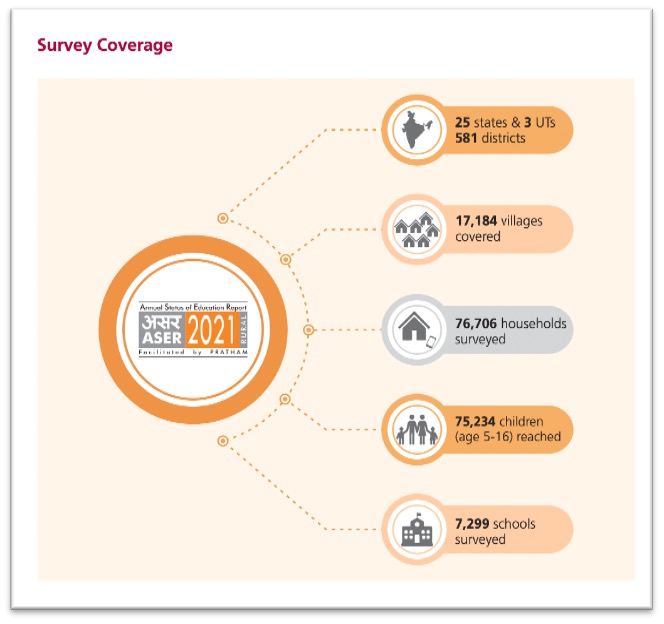
As per the available provisional data, around 33.42 lakh students participated in the NAS-2021 survey. The participation rate is estimated to be around 88%.
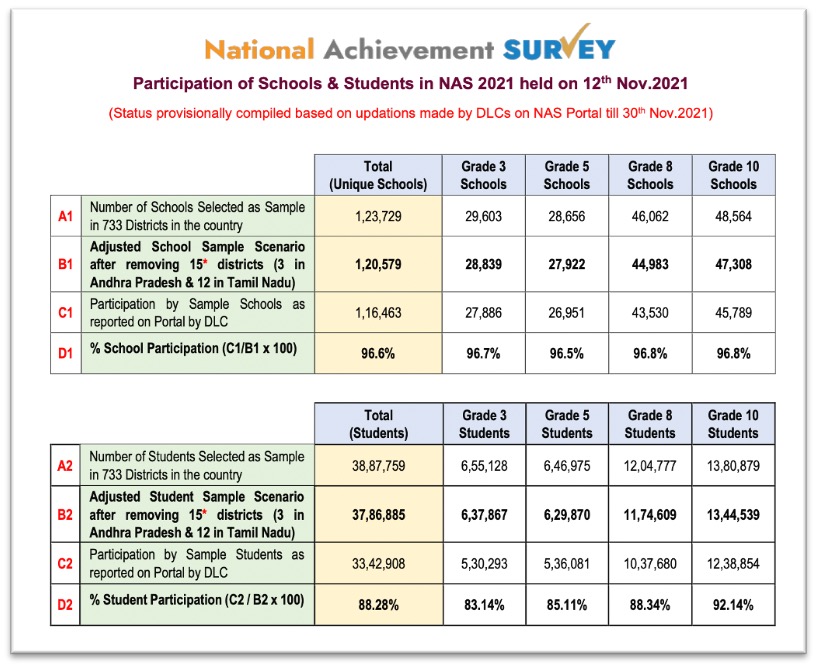
ASER- 2021 provided key insights on the impact of COVID-19 on learning
ASER-2021 provided some important insights which highlight the impact of the COVID-19 pandemic on children’s learning.
- There is a shift in enrolment from Private to Government schools
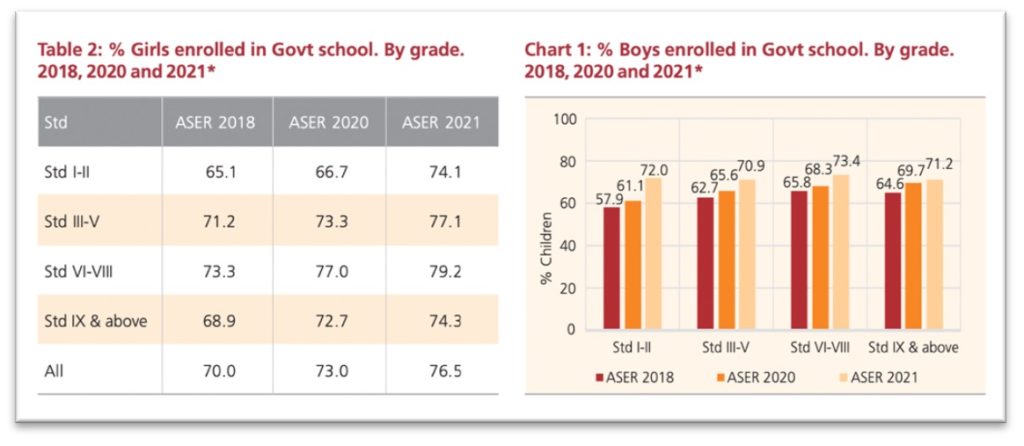
- There is an increase in the proportion of children taking up tuition. As per ASER-2020, 32.5% of students took private tuitions, which increased to 39.2% in ASER -2021. This trend is observed across both boys & girls.
- Children’s access to Smartphones continues to be an issue. Only 27% of the students have access to smartphones all the time while 67% of the students have at least one smartphone at home. Nearly 28% had to buy a new smartphone for children’s education post-pandemic.
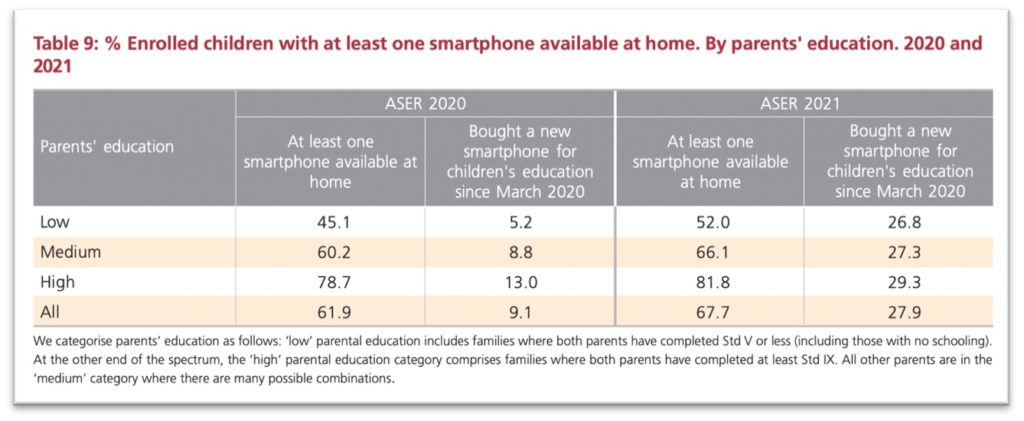
- There is a decrease in learning support at home as the schools reopened. It fell from 74.9% last year to 66% in 2021.
ASER – 2021 also provided insights into major influencing factors on children’s learning and the impact of COVID-19.
The purpose and method followed for NAS-2021 might not throw similar results or insights but would provide critical information on the impact of COVID-19 on children’s learning. It also provides an opportunity to analyse the learning levels compared to earlier and measure the impact of COVID-19 and the closure of schools on learning. It would also bring to light the differences among the students who had access to better resources and those who were dependent on schools being physically open for learning.
Featured Image: School Children


